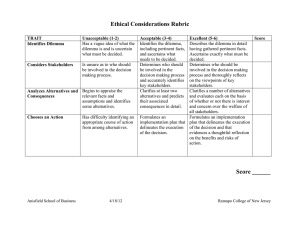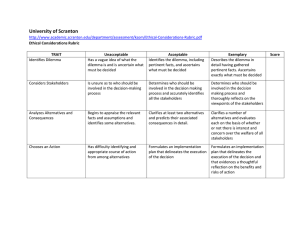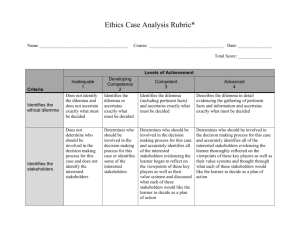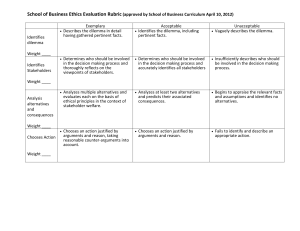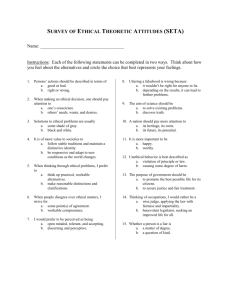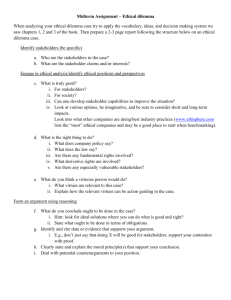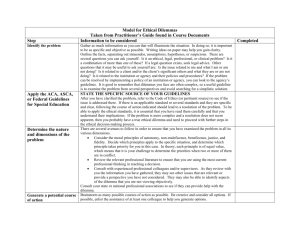Examine the ethical dilemma
advertisement
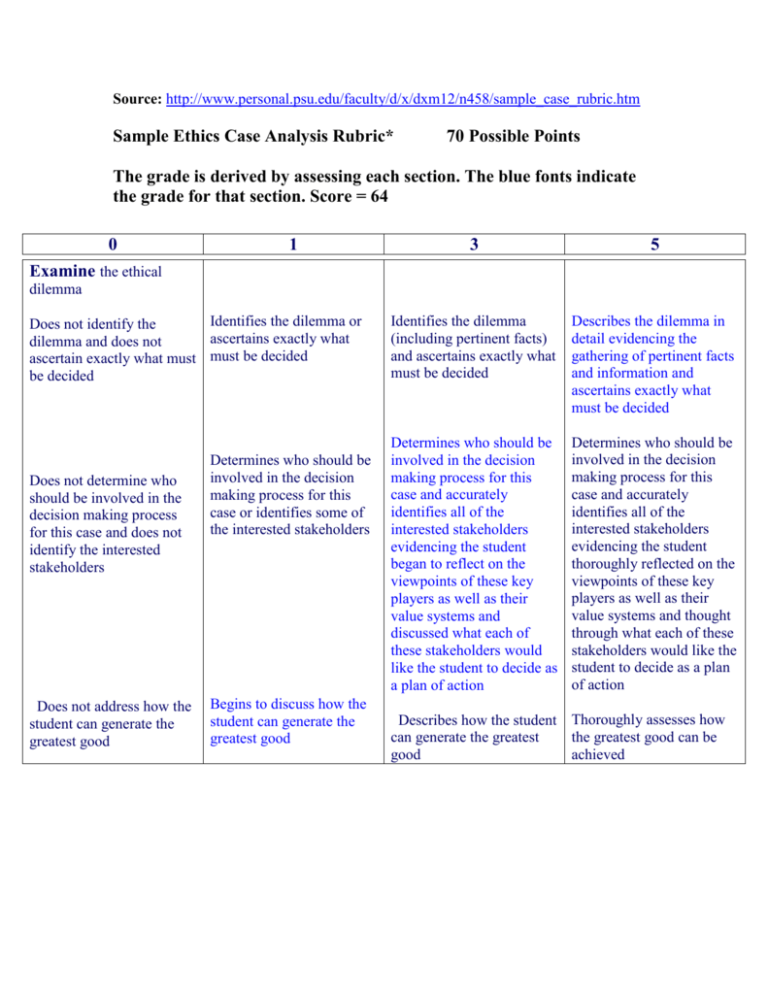
Source: http://www.personal.psu.edu/faculty/d/x/dxm12/n458/sample_case_rubric.htm Sample Ethics Case Analysis Rubric* 70 Possible Points The grade is derived by assessing each section. The blue fonts indicate the grade for that section. Score = 64 0 1 3 5 Identifies the dilemma (including pertinent facts) and ascertains exactly what must be decided Describes the dilemma in detail evidencing the gathering of pertinent facts and information and ascertains exactly what must be decided Determines who should be involved in the decision making process for this case and accurately identifies all of the interested stakeholders evidencing the student began to reflect on the viewpoints of these key players as well as their value systems and discussed what each of these stakeholders would like the student to decide as a plan of action Determines who should be involved in the decision making process for this case and accurately identifies all of the interested stakeholders evidencing the student thoroughly reflected on the viewpoints of these key players as well as their value systems and thought through what each of these stakeholders would like the student to decide as a plan of action Examine the ethical dilemma Identifies the dilemma or Does not identify the ascertains exactly what dilemma and does not ascertain exactly what must must be decided be decided Does not determine who should be involved in the decision making process for this case and does not identify the interested stakeholders Does not address how the student can generate the greatest good Determines who should be involved in the decision making process for this case or identifies some of the interested stakeholders Begins to discuss how the student can generate the greatest good Describes how the student Thoroughly assesses how the greatest good can be can generate the greatest achieved good 0 Thoroughly comprehend 1 3 5 the possible alternatives available Does not delineate any alternatives Does not clarify consequences Delineates 1 alternative Delineates 2 alternatives Delineates 3 alternatives Clarifies one alternative and predicts the associated consequences in detail Clarifies two alternatives and predicts their associated consequences in detail Clarifies 3 alternatives and predicts their associated consequences in detail Identifies an applicable approach Identifies an applicable approach identifying the moral principles that can be brought into play to support a conclusion as to what ought to be done ethically in this case or similar cases Identifies an applicable approach identifying the moral principles that can be brought into play to support a conclusion as to what ought to be done ethically in this case or similar cases and ascertains whether the approaches generate converging or diverging conclusions about what ought to be done Hypothesize ethical arguments Does not determine which of the 5 approaches apply to this dilemma 0 Investigate, compare, 1 3 5 Appraises the relevant facts and assumptions prudently noting the evaluation of any ambiguous information Appraises the relevant facts and assumptions prudently noting the evaluation of any ambiguous information and explores any unjustifiable factual or illogical assumptions, or debatable conceptual issues and evaluate the arguments for each alternative Does not appraise the relevant facts and assumptions prudently Does not rate the ethical reasoning and arguments for each alternative Begins to appraise the relevant facts and assumptions prudently Rates the ethical reasoning and arguments for some of the alternatives Does not give evidence that the student reflected on any of the alternatives Gives evidence that the student began to reflect on the alternatives Does not refer to their professional codes of ethical conduct. Begins to refer to their professional codes of ethical conduct Rates the ethical reasoning and arguments for most of the alternatives Evidences the reflection on the alternatives by evaluating each alternative on the basis of whether or not there is interest and concern over the welfare of all key players Refers to their professional codes of ethical conduct Rates the ethical reasoning and arguments for all of the alternatives Evidences the reflection on the alternatives by evaluating each alternative on the basis of whether or not there is interest and concern over the welfare of all key players and determines which alternative will produce the greatest good or the least amount of harm for the greatest number of people Refers to their professional codes of ethical conduct and determines if it supports their reasoning 0 1 3 5 Determines the best alternative available Determines the best alternative available and describes how their decision maximizes the benefit and minimizes the risk for everyone involved Determines the best alternative available, describes how their decision maximizes the benefit and minimizes the risk for everyone involved, and they challenge their decision as they think others might, and defend it by from the ethical arguments they predict others would use Begins to formulate an implementation plan Formulates an implementation plan that delineates the execution of the decision Formulates an implementation plan that delineates the execution of the decision and evidences a design that will maximize the benefits and minimize the risks while taking into account all of the resources necessary for implementation including personnel and money Choose the alternative you would recommend Does not make a decision about the best alternative available Act on your chosen alternative Does not formulate an implementation plan 0 1 3 5 Problem Solving, decision-making, and critical thinking skills Does not problem solve or use critical thinking skills Evidences the beginning of problem solving and critical thinking Uses problem solving and critical thinking skills during case analysis Is able to make minor decisions. Is able to make major decisions Has difficulty making decisions Uses problem solving and critical thinking skills throughout the entire case analysis Is able to make major decisions with rationale Penn State- 400 level class *Based on the Ethical Model for Ethical Decision Making developed and owned by Educational Advancement Associates.
